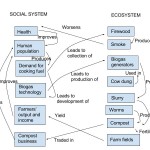Biogas technology changed human-environment interactions in India. Before its introduction, the rate of collection of firewood for cooking fuel was not sustainable. Biogas technology reduced the demand for firewood, thus creating a more sustainable situation. But biogas technology had other effects besides cutting down on smoke, reducing firewood depletion, and increasing children’s time for school. The by-product, slurry, also improved the lives of the people via the trade and use of compost produced from the slurry. To start comparing my diagram to Marten’s, both include reasons for introduction of biogas generators, and effects beyond better cooking fuel. One difference, however, is that the diagram in Marten includes the positive-feedback effect that demand for cooking fuel had prior to introduction of biogas generators. My diagram doesn’t include that because that aspect wasn’t mentioned in the video. Also, I included the compost business as that aspect was not discussed in the Marten text. Obviously, there are similarities between the two diagrams because they are about the same subject. There are differences because they address slightly different aspects of it. One thing we can say from comparing the two diagrams is that things can have greater consequences than we might initially anticipate. When we draw a diagram, we can choose to emphasize different aspects of a topic.
One thought on “Biogas in India”
Leave a Reply
You must be logged in to post a comment.


I am very impressed by your diagram and the uses of verbs with the connection lines. You mentioned that this system is sustainable with the assumption that manure is readily available. The video said this is the case but due to the principles of supply and demand will this be the case when manure is used for heating?
Your diagram hints that worsened heath leads to increased population unless I am misreading it.
Take a look at my diagram. I make a connection about increased income could lead to better education which in turn leads to increased income a positive feedback loop.
http://geog030.dutton.psu.edu/2016/01/27/42864/